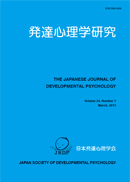
- Issue 4 Pages 175-
- Issue 3 Pages 123-
- Issue 2 Pages 63-
- Issue 1 Pages 1-
- |<
- <
- 1
- >
- >|
-
Michika Takiyoshi, Daisuke Suzuki, Mari Tanaka2017Volume 28Issue 2 Pages 63-73
Published: 2017
Released on J-STAGE: June 20, 2019
JOURNAL FREE ACCESSThis study analyzed how people with typical development (TD) perceive awkwardness during different stages of life and contrasted these perceptions with cognitions about people with autism spectrum disorder (ASD). Participants (ns=214 people with TD, 111 people with ASD, ages 9–60) were asked when they felt awkward. Their responses were grouped into 12 categories and analyzed. The results showed that elementary school-aged TD participants felt awkward when another person's opinions or feelings opposed their own. High school students felt awkward in interpersonal relationships. Meanwhile, ASD participants ages 16 and older failed to understand the relationship between themselves and others, or to immediately sense the atmosphere of other people. ASD participants were especially less perceptive of awkwardness in the contexts of conversations and facial or non-verbal cues. However, they tended to feel awkward when they could not handle an issue on their own. The discussion concerned the characteristics and development of cognitions of awkwardness that people with ASD perceive in comparison to people with TD.
View full abstractDownload PDF (742K) -
Hidemi Kudo2017Volume 28Issue 2 Pages 74-83
Published: 2017
Released on J-STAGE: June 20, 2019
JOURNAL FREE ACCESSThis study investigated the ages at which children can reverse ambiguous figures without any suggestion of another interpretation. When children cannot reverse the figures, we also considered whether or not they reverse them more easily after having observed the process of disassembling a figure (e.g., perceived as a rabbit) into pieces and then reassembling the pieces into the exactly same composition as previously presented, but with the pretext that the figure would be different (e.g., a duck). The results showed that a majority of 5-year-old children easily succeed in making alternative interpretations, whereas 3-year-olds stick to their first interpretations and cannot find another one. We found that the de- and re-construction procedure facilitates the spontaneous reversal of ambiguous figures only for 5-year-old children, whereas there was no such effect for 3- to 4- year-olds. Our findings suggest that it is not until age 5 that children come to understand the representational nature of interpretations of ambiguous figures.
View full abstractDownload PDF (769K) -
Shogo Hihara, Kazumi Sugimura2017Volume 28Issue 2 Pages 84-95
Published: 2017
Released on J-STAGE: June 20, 2019
JOURNAL FREE ACCESSThis study examined the validity of a procedure to identify adolescents choosing a negative identity, by using the Twenty Statements Test (TST). In Study 1, 222 (Survey 1) and 204 (Survey 2) Japanese university students completed questionnaires. Consistent with our hypotheses, students in the negative identity group scored lower on identity achievement, trust, and environmental exploration, and higher on guilt and career indecision, than did their peers in the other groups. There was no significant difference in self-exploration among the groups. In Study 2, 22 university students took part in interviews. Students in the negative identity group stated their negative self-definitions more clearly than did individuals in the other groups. Moreover, they had experienced identity crisis, guilt, and crisis of trust. Overall, these results reveal that the procedure used in this study was effective for identification of adolescents who choose a negative identity.
View full abstractDownload PDF (747K) -
Hidenori Miyake, Shinichiro Sugimura2017Volume 28Issue 2 Pages 96-105
Published: 2017
Released on J-STAGE: June 20, 2019
JOURNAL FREE ACCESSThe purpose of this study was to examine the effect of directive words on young children's ability to integrate speech and gesture in comprehension. In this study, 3- to 6-year-old children (N=210) were presented with a combination of two types of spoken sentences and gestures. They were divided into two groups. One was the group in which children were presented gestures and speech with directive words, and the other was the group in which they were presented gestures and speech without directive words. Using iconic gesture in Experiment 1 and abstract gesture in Experiment 2, the participants were asked to select an object that best matched the message. The result showed that young children in the group with directive words integrated speech and gesture more than the group without directive words. The proportion who made the right choice selecting speech and gesture increased with age in Experiment 1, but it did not increase with age in Experiment 2. Based on our results, we discuss how young children's ability to integrate speech and gesture can be developed.
View full abstractDownload PDF (1025K) -
Hiroshi Fujino, Tomoko Matsui, Yoshikuni Tojo, Koichiro Hakarino2017Volume 28Issue 2 Pages 106-114
Published: 2017
Released on J-STAGE: June 20, 2019
JOURNAL FREE ACCESSWe investigated the effect of verbal proposition cues related to the basic principle of false-belief in children with Autism Spectrum Disorder (ASD), and discussed the findings from the perspective of verbal ability. The participants were 54 children with ASD from 6–12 years of age. A pre-test was administered using a false-belief task. Twenty-nine children who did not pass the pre-test were given another false-belief task as an intervention. In this task, the ‘seeing leads to knowing' principle was provided verbally before the belief question. Children who passed this task were given another false-belief task without verbal cues as a post-test for a probe. They were also asked to state the reasons for their answers. Four children passed the intervention task and post-test, and two children among them referred to relations between perception and knowledge as reasons for their answers. Their verbal ages were over 10 years. These results suggest that verbal proposition cues can facilitate false-belief reasoning, in ASD children with a verbal age of 10 years who can understand the false-belief principle and generalize from it.
View full abstractDownload PDF (811K)
- |<
- <
- 1
- >
- >|